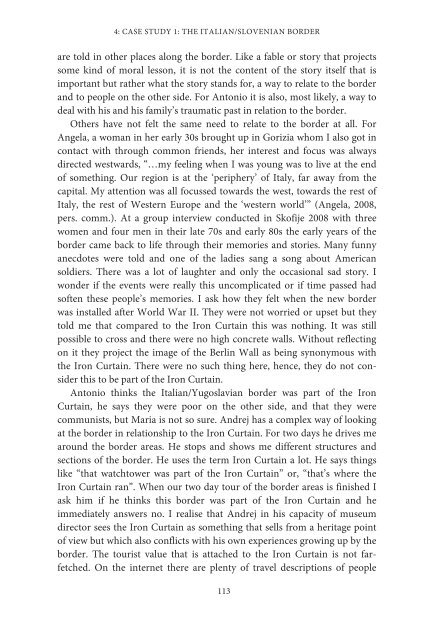1JZGauQ
1JZGauQ
1JZGauQ
Create successful ePaper yourself
Turn your PDF publications into a flip-book with our unique Google optimized e-Paper software.
4: CASE STUDY 1: THE ITALIAN/SLOVENIAN BORDER<br />
are told in other places along the border. Like a fable or story that projects<br />
some kind of moral lesson, it is not the content of the story itself that is<br />
important but rather what the story stands for, a way to relate to the border<br />
and to people on the other side. For Antonio it is also, most likely, a way to<br />
deal with his and his family’s traumatic past in relation to the border.<br />
Others have not felt the same need to relate to the border at all. For<br />
Angela, a woman in her early 30s brought up in Gorizia whom I also got in<br />
contact with through common friends, her interest and focus was always<br />
directed westwards, “…my feeling when I was young was to live at the end<br />
of something. Our region is at the ‘periphery’ of Italy, far away from the<br />
capital. My attention was all focussed towards the west, towards the rest of<br />
Italy, the rest of Western Europe and the ‘western world’” (Angela, 2008,<br />
pers. comm.). At a group interview conducted in Skofije 2008 with three<br />
women and four men in their late 70s and early 80s the early years of the<br />
border came back to life through their memories and stories. Many funny<br />
anecdotes were told and one of the ladies sang a song about American<br />
soldiers. There was a lot of laughter and only the occasional sad story. I<br />
wonder if the events were really this uncomplicated or if time passed had<br />
soften these people’s memories. I ask how they felt when the new border<br />
was installed after World War II. They were not worried or upset but they<br />
told me that compared to the Iron Curtain this was nothing. It was still<br />
possible to cross and there were no high concrete walls. Without reflecting<br />
on it they project the image of the Berlin Wall as being synonymous with<br />
the Iron Curtain. There were no such thing here, hence, they do not consider<br />
this to be part of the Iron Curtain.<br />
Antonio thinks the Italian/Yugoslavian border was part of the Iron<br />
Curtain, he says they were poor on the other side, and that they were<br />
communists, but Maria is not so sure. Andrej has a complex way of looking<br />
at the border in relationship to the Iron Curtain. For two days he drives me<br />
around the border areas. He stops and shows me different structures and<br />
sections of the border. He uses the term Iron Curtain a lot. He says things<br />
like “that watchtower was part of the Iron Curtain” or, “that’s where the<br />
Iron Curtain ran”. When our two day tour of the border areas is finished I<br />
ask him if he thinks this border was part of the Iron Curtain and he<br />
immediately answers no. I realise that Andrej in his capacity of museum<br />
director sees the Iron Curtain as something that sells from a heritage point<br />
of view but which also conflicts with his own experiences growing up by the<br />
border. The tourist value that is attached to the Iron Curtain is not farfetched.<br />
On the internet there are plenty of travel descriptions of people<br />
113




